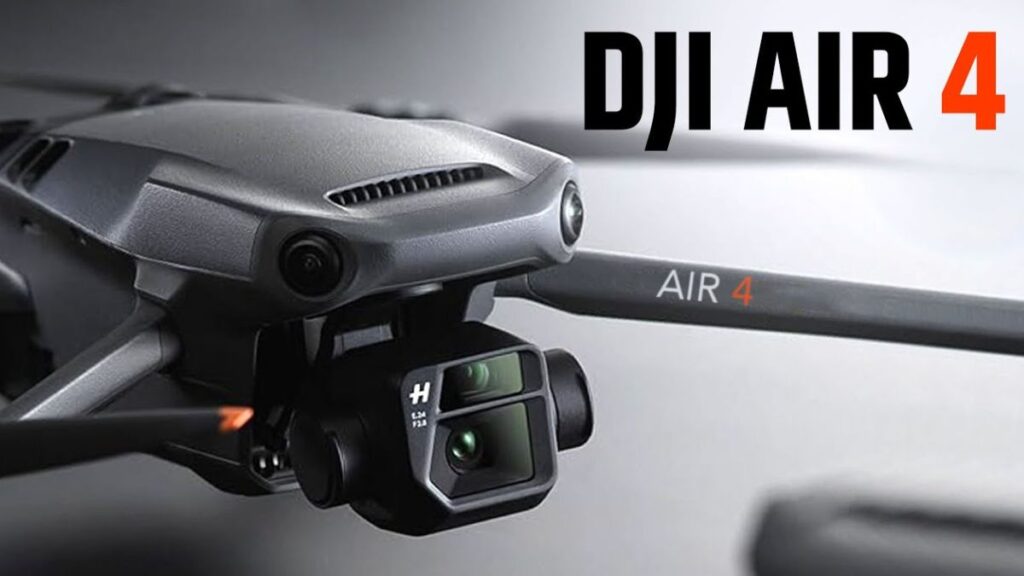DJI fans are watching closely as the DJI Air 4 prepares for its debut, and it looks like this next-generation drone could bring meaningful upgrades to the compact drone segment. Known for balancing portability with powerful features, the Air series has been a reliable choice for creators who want solid performance without stepping into the bulkier professional line. With DJI‘s history of refining features with each release, the Air 4 could set a new standard by improving flight time, camera quality, and intelligent flight functionality. It’s a step that seems to be built on everything the Air 3 did well, with enough added punch to attract both upgraders and new drone users.
Today’s Best DJI Air 3 Amazon Deal

Mason knows photography inside and out. With 15 years of hands-on experience, he’s written about cameras, lenses, and gear of all kinds. He even spent five years as a journalist, diving deep into music and writing sharp, engaging stories. Now, Mason shares his photography knowledge, helping readers find the right gear and perfect their skills. He’s also proud of his unbeatable Wordle streak!
Expected Features of the DJI Air 4
From what’s been circulating, the DJI Air 4 is likely to push forward in all the right areas. One of the most anticipated changes is the upgraded camera system. DJI may introduce a larger sensor, potentially a 1-inch or slightly smaller CMOS unit, with improved optics. This would give the Air 4 better resolution, superior low-light performance, and support for vertical shooting—a feature growing more relevant in today’s short-form video era.
Battery performance could also get a noticeable boost. Rumors suggest a higher-capacity battery that might push the flight time to 38–40 minutes, outlasting the Air 3’s 46-minute maximum under optimal conditions. Coupled with faster charging, this would mean more time in the air and less waiting on the ground—an upgrade that’s especially useful for on-the-go creators and frequent travelers.
The drone’s body may also see structural upgrades. A sturdier frame, potentially with thicker arms or redesigned airframe dynamics, could improve durability and reduce vibration in high-speed flight, without losing the foldable and travel-friendly design that’s become a hallmark of the Air lineup. Even if it gets slightly larger, it’s still expected to remain under the 600g mark, making it an easy fit in a camera bag or small backpack.
Safety and ease of control should also improve thanks to enhanced obstacle avoidance. DJI might take a cue from the Mini 4 Pro’s omnidirectional system, adding more sensors and better mapping algorithms to help the drone navigate complex environments more safely. Alongside that, the Air 4 is expected to launch with new intelligent flight modes. These could include a refined version of FocusTrack, improved subject recognition, AI-guided shooting, and smoother automated flight routes—all designed to take the guesswork out of cinematic content creation.
DJI Air 4 vs Air 3: Key Differences
The DJI Air 4 will offer meaningful upgrades over the Air 3, especially in areas that matter most to content creators. Starting with the camera, the Air 4 is likely to deliver a significant improvement thanks to a larger sensor and improved image processing. This means cleaner photos, more dynamic range, and better clarity in low-light conditions. The addition of native vertical shooting also opens up more creative possibilities for social-first content, something the Air 3 doesn’t offer out of the box.
Flight time is another area expected to improve. The Air 3 already delivered solid numbers, but the Air 4 might stretch things even further with a more efficient power system and better battery management, potentially increasing flight time by 10–15% depending on usage.
In terms of design, the Air 4 may not look radically different at first glance, but subtle changes like stronger arms, better wind resistance, and an updated gimbal design could give it better handling and more stability in tricky conditions. It will likely retain its foldable architecture, keeping it compact and convenient for everyday use.
Another major shift could come in the form of software and autonomous features. The Air 4 is expected to include upgrades to ActiveTrack, enhanced waypoint control, and a new level of AI-assisted video creation. These additions would help both hobbyists and professionals capture polished footage with minimal manual input. If DJI also upgrades the transmission system to something on par with OcuSync 4.0, users can expect a longer range and more stable video feeds even in areas with signal interference.
Competitors in the Compact Drone Market: DJI Mini 4 Pro & Autel EVO Nano+
The Air 4 isn’t launching into an empty field—it’s entering a compact drone market full of competitive options. Two of the biggest rivals are the DJI Mini 4 Pro and Autel Robotics EVO Nano+.
The Mini 4 Pro keeps things extremely light at just 8.8 oz, which makes it a great option for those wanting to stay under regulation thresholds. It still manages to pack in impressive features like a 4K100 camera, 48MP RAW stills, omnidirectional obstacle avoidance, and up to 34 minutes of flight time. Its rotating gimbal supports vertical shooting—a major plus for social media content. Plus, the OcuSync 4.0 transmission allows for a 12.4-mile range, and the RC 2 controller enhances usability right out of the box.
In comparison, while the Mini 4 Pro is incredibly portable, it may fall slightly behind the Air 4 in terms of sensor size, stability in windy conditions, and obstacle avoidance sophistication, depending on DJI’s final specs. However, if staying ultra-light and avoiding registration is your top priority, the Mini 4 Pro is tough to beat.
Then there’s the Autel EVO Nano+. Despite its tiny footprint and 8.8 oz weight, this drone manages to squeeze in a 1/1.28″ CMOS sensor that captures 50MP stills and shoots 4K30 HDR video. The 3-axis gimbal, dynamic subject tracking, and 3-way binocular obstacle avoidance make it a powerful little drone. It can fly for up to 28 minutes and transmit 2.7K video over a distance of 6.2 miles. Features like SkyPortrait allow for group aerial selfies, which adds to its appeal for casual and social content creators.
Compared to the expected capabilities of the DJI Air 4, the EVO Nano+ excels in compactness and image quality for its size, but may lack the flight time, transmission range, and advanced intelligent flight modes that DJI could deliver with the Air 4. Both competitors are strong in their own way, but the Air 4 seems set to appeal more to those who want a little more pro-grade performance without moving into the bulk and cost of a Mavic 3 or Inspire.
Release Date and Pricing
DJI hasn’t dropped an official release date for the Air 4 yet, but industry insiders suggest we could see an announcement by late 2025. This timing would align well with DJI’s past release cycles, giving them time to polish features and gather feedback from earlier models. A summer or early autumn release would also make sense seasonally, catching peak drone hobbyist activity.
As for pricing, nothing is set in stone, but the Air 4 will likely land in a similar range to the Air 3, possibly around $999 to $1,199 USD depending on configuration and accessories. If DJI offers combo packages—like Fly More Kits or advanced RC bundles—pricing could go up to $1,399 or more. That would keep it competitive within the mid-tier compact drone category while justifying its advanced capabilities. For buyers who want a step up from entry-level drones like the Mini 4 Pro or EVO Nano+ without moving into the high-end Mavic territory, the Air 4 could strike the perfect balance.
What’s the DJI Air 4 expected to have?
The DJI Air 4 is expected to have a better camera, a longer battery life, and more safety features. Rumors say the camera will have a bigger sensor, giving it sharper images and better low-light shots. The battery might last up to 38–40 minutes, which means more time in the air. Plus, there could be new flight modes to make filming easier.
How does the DJI Air 4 compare to the Air 3?
The DJI Air 4 should have a better camera, longer flight time, and smarter features compared to the Air 3. Expect cleaner photos, better battery life, and easier flight controls. The Air 4 could also handle wind and tricky conditions better, making it more stable in the air.
Can the DJI Air 4 shoot in vertical mode?
Yes! The DJI Air 4 is likely to have vertical shooting, making it perfect for social media content like TikToks and Instagram stories.
When will the DJI Air 4 be available?
DJI hasn’t confirmed the release date yet, but insiders believe it could drop in late 2025. It’s likely to be released in summer or fall, just in time for peak drone season.
How much will the DJI Air 4 cost?
The DJI Air 4 might cost between $999 and $1,199 USD, depending on the model. With extra accessories or combo packages, the price could go up to $1,399 or more.
Conclusion
All signs point to the DJI Air 4 being a solid evolution of the Air series. With a probable upgrade to the camera sensor, better battery life, sturdier design, and smarter flight features, this drone seems ready to give users more creative power in a portable package. It’s clearly designed with content creators and semi-professionals in mind—those who want high-quality aerial footage without lugging around a full-sized drone.
While the Mini 4 Pro and Autel EVO Nano+ offer strong alternatives in the compact space, especially for casual users and travelers, the Air 4 could hit a sweet spot between performance and portability. With more power and precision than most lightweight models and greater convenience than full-sized drones, the Air 4 looks ready to become a go-to tool for the next wave of aerial storytellers. Keep an eye out for more details as we get closer to launch—this one’s worth watching.


